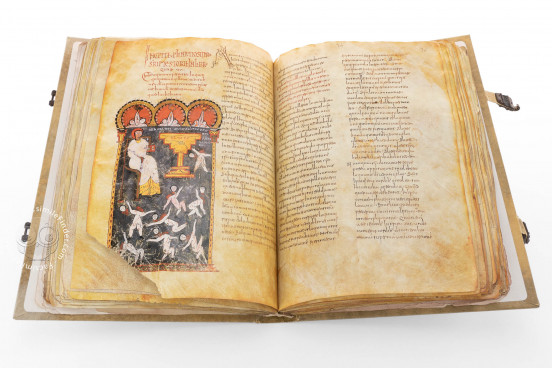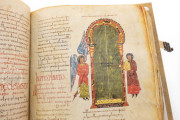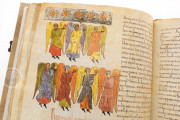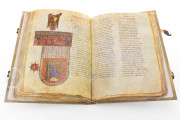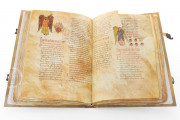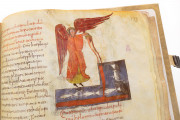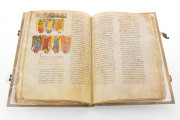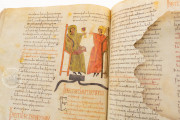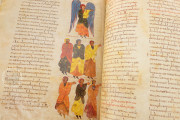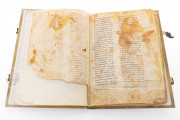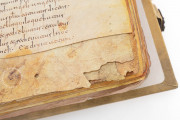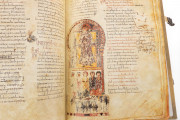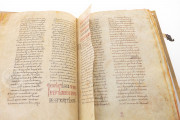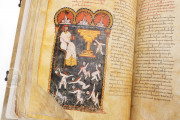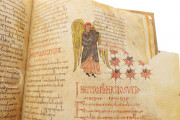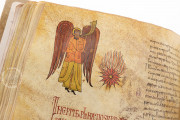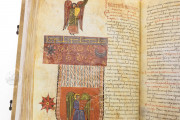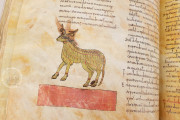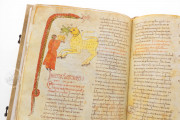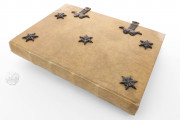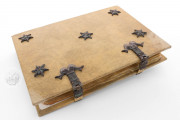The Vitrina 14-1 Codex of the Christian biblical book of the Apocalypse with commentary by Beatus of Liébana was made in the mid-tenth century in northern Spain, perhaps at one of the monasteries of San Millán de la Cogolla. Although only fragmentarily preserved, it is important for being one of the earliest surviving manuscripts in the centuries-long tradition of extensively illuminated manuscripts of Beatus's commentary. Its twenty-seven paintings are mostly unframed miniatures in richly saturated colors creating bold patterns against the unpainted parchment.
The manuscript's miniatures illustrate Saint John the Divine's vision of events leading to Christ's final judgment of humanity, including angels blowing trumpets (fols. 96-108) and pouring out vessels (fols. 132-135) that unleash terrifying disasters such as falling stars and bodies of water turning into blood.
A Distinctive Painting Style
The style of the Madrid manuscript's miniatures is distinctive and related to the painting style found in the Visigothic-Mozarabic Bible of San Isidoro. The palette is restricted to the primary and secondary hues of red, yellow, blue, orange, green, and purple. The colors are applied boldly, with details of drapery and facial features rendered in colored lines. The illuminator or illuminators seem to have been familiar with the artistic vocabulary of contemporary Islamic Spain.
God's Wrath
The Winepress of God's Wrath (Apocalypse 14:14-20) occupies a full page of the large manuscript (fol. 127v) and illustrates the biblical text in great detail, showing the son of man with a sickle on a cloud, angels coming from a temple and from an altar, the reaping of grapes, and the treading of the grapes in a press.
Two more miniatures extend across the whole width of the page, showing the witnesses taken up into heaven (fol. 107r) and the plague angels with their vessels (fol. 130r). The remaining paintings are vignettes that fit within a column of the manuscript's two-column text.
Text in Visigothic Minuscule
The original text is written in Visigothic Minuscule. It was corrected by a scribe writing Caroline Minuscule. Headings in red introduce each storia (i.e., a section of the biblical text) and each explanatio (i.e., a section of Beatus's allegorical commentary).
Road to the National Library
Although it is uncertain where the Vitrina 14-1 Beatus was copied and illuminated, it was probably at one of the monasteries of San Millán de la Cogolla in northern Spain already in the high Middle Ages. Before entering the Biblioteca Nacional, the manuscript was in the possession of the poet, historian, and bibliophile Serafín Estébanez Calderón (1799-1867). All the codices in the Iberian tradition of Beatus of Liébana were named to UNESCO's Memory of the World Register in 2015.
_____
For more information on the Beatus model, read our blog article by Amy R. Miller (PhD, Medieval Art History, University of Toronto).
We have 1 facsimile edition of the manuscript "Beatus of Liébana - Vitrina 14-1 Codex": Beato "Emilianense" de la Biblioteca Nacional facsimile edition, published by Siloé, arte y bibliofilia, 2007
Request Info / Price
